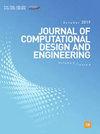Structural optimization of multistage centrifugal pump via computational fluid dynamics and machine learning method
IF 6.1
2区 工程技术
Q1 COMPUTER SCIENCE, INTERDISCIPLINARY APPLICATIONS
引用次数: 1
Abstract
To implement energy savings in multistage centrifugal pumps, a return channel is utilized to replace the origin inter-stage flow channel structure, and then a single-objective optimization work containing high-precision numerical simulation, design variable dimensionality reduction, and machine learning is conducted to obtain the optimal geometric parameters. The variable dimensionality reduction process is based on the Spearman correlation analysis method. The influence of 15 design variables of the impeller and return channel is investigated, and seven of them with high-impact factors are selected as the final optimization variables. Thereafter, a genetic algorithm-backpropagation neural network (GA-BPNN) model is used to create a surrogate model with a high-fitting performance by employing a GA to optimize the initial thresholds and weights of a BPNN. Finally, a multi-island genetic algorithm (MIGA) is employed to maximize hydraulic efficiency under the nominal condition. The findings demonstrate that the optimized model’s efficiency is increased by 4.29% at 1.0Qd, and the deterioration of the pump performance under overload conditions is effectively eliminated (the maximum efficiency increase is 14.72% at 1.3Qd). Furthermore, the internal flow analysis indicates that the optimization scheme can improve the turbulence kinetic energy distribution and reduce unstable flow structures in the multistage centrifugal pump.基于计算流体力学和机器学习方法的多级离心泵结构优化
为了实现多级离心泵的节能,利用回程通道取代原有的级间流道结构,然后进行高精度数值模拟、设计变维降维和机器学习的单目标优化工作,获得最优的几何参数。变维降维过程基于Spearman相关分析法。研究了叶轮和回流道15个设计变量的影响,选取影响因子较大的7个设计变量作为最终优化变量。然后,采用遗传算法-反向传播神经网络(GA-BPNN)模型,通过遗传算法优化BPNN的初始阈值和权重,创建具有高拟合性能的代理模型。最后,采用多岛遗传算法(MIGA)实现了标称工况下的水力效率最大化。结果表明,优化后的模型在1.0Qd时效率提高了4.29%,有效消除了泵在过载条件下的性能劣化(在1.3Qd时效率最大提高了14.72%)。此外,内部流动分析表明,优化方案可以改善多级离心泵的湍流动能分布,减少不稳定的流动结构。
本文章由计算机程序翻译,如有差异,请以英文原文为准。
求助全文
约1分钟内获得全文
求助全文
来源期刊

Journal of Computational Design and Engineering
Computer Science-Human-Computer Interaction
CiteScore
7.70
自引率
20.40%
发文量
125
期刊介绍:
Journal of Computational Design and Engineering is an international journal that aims to provide academia and industry with a venue for rapid publication of research papers reporting innovative computational methods and applications to achieve a major breakthrough, practical improvements, and bold new research directions within a wide range of design and engineering:
• Theory and its progress in computational advancement for design and engineering
• Development of computational framework to support large scale design and engineering
• Interaction issues among human, designed artifacts, and systems
• Knowledge-intensive technologies for intelligent and sustainable systems
• Emerging technology and convergence of technology fields presented with convincing design examples
• Educational issues for academia, practitioners, and future generation
• Proposal on new research directions as well as survey and retrospectives on mature field.
 求助内容:
求助内容: 应助结果提醒方式:
应助结果提醒方式:


